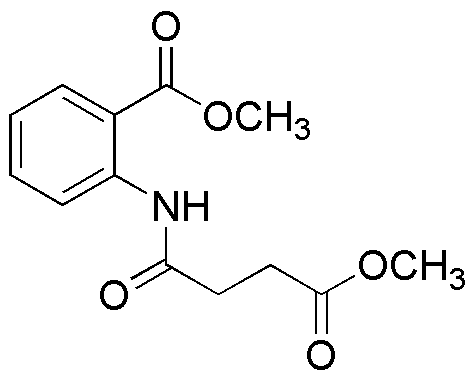Methyl 2-(4-Methoxy-4-Oxobutanamido)Benzoate is widely utilized in research focused on:
- Pharmaceutical Development: This compound serves as an intermediate in the synthesis of various pharmaceuticals, particularly in the development of drugs targeting metabolic disorders.
- Cosmetic Formulations: Due to its properties, it is used in cosmetic products to enhance skin absorption and improve the efficacy of active ingredients.
- Agricultural Chemicals: It plays a role in the formulation of agrochemicals, providing effective solutions for pest control while being less harmful to beneficial insects.
- Biochemical Research: Researchers utilize this compound in studies related to enzyme inhibition and metabolic pathways, aiding in the discovery of new therapeutic targets.
- Polymer Chemistry: It is incorporated into polymer formulations to enhance mechanical properties and thermal stability, making it valuable in materials science.
General Information
Properties
Safety and Regulations
Applications
Methyl 2-(4-Methoxy-4-Oxobutanamido)Benzoate is widely utilized in research focused on:
- Pharmaceutical Development: This compound serves as an intermediate in the synthesis of various pharmaceuticals, particularly in the development of drugs targeting metabolic disorders.
- Cosmetic Formulations: Due to its properties, it is used in cosmetic products to enhance skin absorption and improve the efficacy of active ingredients.
- Agricultural Chemicals: It plays a role in the formulation of agrochemicals, providing effective solutions for pest control while being less harmful to beneficial insects.
- Biochemical Research: Researchers utilize this compound in studies related to enzyme inhibition and metabolic pathways, aiding in the discovery of new therapeutic targets.
- Polymer Chemistry: It is incorporated into polymer formulations to enhance mechanical properties and thermal stability, making it valuable in materials science.
Documents
Safety Data Sheets (SDS)
The SDS provides comprehensive safety information on handling, storage, and disposal of the product.
Product Specification (PS)
The PS provides a comprehensive breakdown of the product’s properties, including chemical composition, physical state, purity, and storage requirements. It also details acceptable quality ranges and the product's intended applications.
Certificates of Analysis (COA)
Search for Certificates of Analysis (COA) by entering the products Lot Number. Lot and Batch Numbers can be found on a product’s label following the words ‘Lot’ or ‘Batch’.
Numéro de catalogue
Numéro de lot/série
Certificates Of Origin (COO)
This COO confirms the country where the product was manufactured, and also details the materials and components used in it and whether it is derived from natural, synthetic, or other specific sources. This certificate may be required for customs, trade, and regulatory compliance.
Numéro de catalogue
Numéro de lot/série
Safety Data Sheets (SDS)
The SDS provides comprehensive safety information on handling, storage, and disposal of the product.
DownloadProduct Specification (PS)
The PS provides a comprehensive breakdown of the product’s properties, including chemical composition, physical state, purity, and storage requirements. It also details acceptable quality ranges and the product's intended applications.
DownloadCertificates of Analysis (COA)
Search for Certificates of Analysis (COA) by entering the products Lot Number. Lot and Batch Numbers can be found on a product’s label following the words ‘Lot’ or ‘Batch’.
Numéro de catalogue
Numéro de lot/série
Certificates Of Origin (COO)
This COO confirms the country where the product was manufactured, and also details the materials and components used in it and whether it is derived from natural, synthetic, or other specific sources. This certificate may be required for customs, trade, and regulatory compliance.


